
January 3, 2006
ALMA Prototype
Antenna Evaluation OverviewEvaluation Overview
28
API5D Path Length Stability Measurement Results





| ¥The 3 minute timescale corresponds to the timescale over which wind
characteristics (speed or direction) change. |
|
| ¥Measurements shown encompassed a variety of antenna mostions (FS, OTF,
sidereal tracking, etc.). |
|
| ¥Measurement time periods were (L1,L2,L3,L4) = (250,360,25,est) hours
and (est,360,25,est) hours for VertexRSI and AEC. |
|
| ¥The daily temperature variation of the fork arms and the corresponding
path length variation Delta(L2) are correlated. These temperataure-induced variations can be approximated
with good accuracy by sine--functions. This holds also for the ambient air
temperature, at least as measured at the VLA site during most of the time of
the tests. When adopting a sine--function |
|
| L$_{2}$(t) = L$_{\rm o}$ +
$\Delta$L$_2\sin(\omega\,t)$, |
|
| with $\omega$ =
2\,$\pi$/24\,h and t = time, the path length variation $\Delta$\,L$_{2}$ at a
3, 10, and 30 minute time interval can be derived by differentiation of the
function L$_{2}$(t). The corresponding result is shown by solid lines, which
gives an explanation of the double peaked form of the measured
variations. The minima of
$\Delta$\,L$_{2}$ occur around noon and midnight where the temperature
changes of the ambient air and the steel of the fork are smallest. |